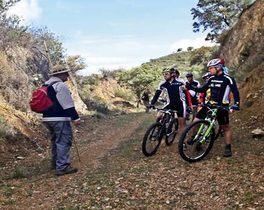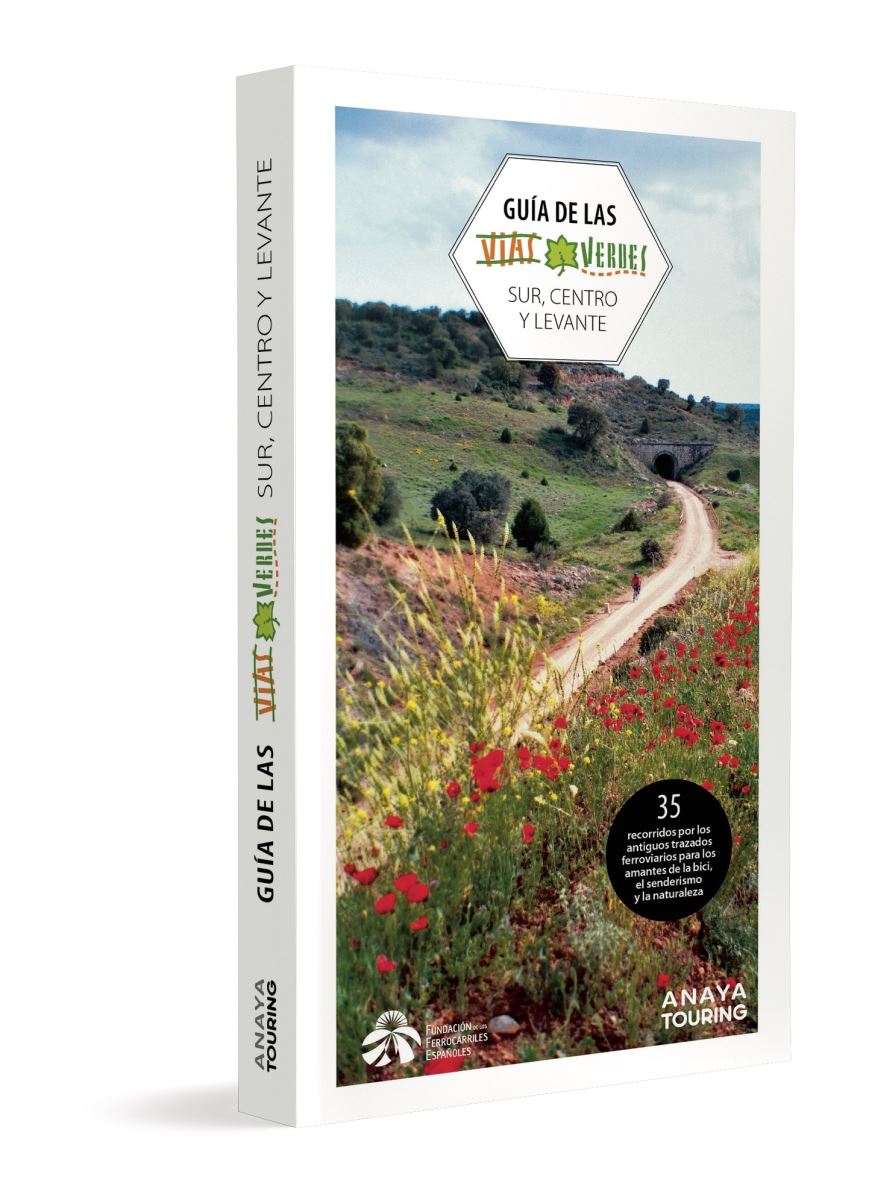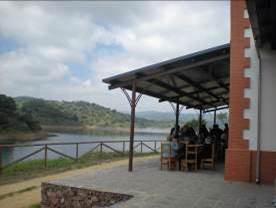|
 Back to index Back to index
|
| Itineraries > El Ronquillo Greenway |
|
|

|
Ahead of us lies a walk or bike ride along the banks of the Minilla reservoir. A magnificent landscape of pasture land and oak woods in which water is never far away. The silence is scarcely broken by the splash of leaping fish or the cry of an azure-winged magpie. This is the El Ronquillo Greenway. We describe a south to north route, the same route taken by the empty trains returning to the mine after unloading their ore.
This Greenway has been carried out by the Provincial Goverment of Andalucia (Tourism Council), the El Ronquillo Town Hall and the Seville Provincial Council.
|
| WRITE YOUR REVIEW
|
| Technical Data
|
|
 CONDITIONED GREENWAY CONDITIONED GREENWAY
|
LOCATION
Between the old El Ronquillo station (Crta. N-630, Km 775) y Seville-Huelva provincial boundary.
|
|
|
|
Natural setting:
Rivera de Huelva river valley, the Minilla reservoir.
Cultural Heritage:
The old center of El Ronquillo.
Infraestructure:
Greenway.
Services:
4 rest areas. 2 large parking areas with space for buses, located at the beginning of the greenway next to the hotel-restaurant and another one in the intermediate section (access from the Ronquillo) km 6.3.
Recovered stations:
El Ronquillo station: hotel-restaurant.
How to get there:
By car: if you access by car, here are the following accesses:
Access nº 1: from the A-66 motorway, from Seville to Mérida, we take exit 782 towards the N-630, at the roundabout we take the 2nd exit (on the left) towards Venta del Alto. You have to travel approximately 10 km along the N-630 to get to the greenway.
GPS coordinates (decimal format): 37.676574°, -6.184294°.
Access nº 2: from the center of El Ronquillo, there are informational signs to access the regional road C-421, for 4 km (a section of secondary road with many curves, not suitable for people with wheelchairs and children).
GPS coordinates (decimal format): 37.717341°, -6.212297°.
Public transport: bus.
Connections:
Sevilla : 49 km to El Ronquillo.
Huelva : 130 km to El Ronquillo.
|
 |
|
|
|
|
| Description
|
|
|
|
We immediately take our leave of the N-630 at Km 775 and join the disused railway line. We need to be careful not to miss this hard-to-see entry point. Once off the road and on a short access path to the greenway a number of sights remind us that we are following an old train route: a narrow path taking us under a bridge and, at the end of the path, a splendid station.
How easy it is to slip back into the past when the station has been so faithfully reconstructed! The old El Ronquillo Station has been carefully refurbished and today offers restaurant, accommodation and information services. Here we can leave our car and start along the trail (except for Mondays and Tuesdays when it is closed and we will have to park before the access barrier).
 
.jpg) In front of us the lake landscape is alternately revealed by a succession of balcony-like viewing points and concealed by the trees lining the route. We pass through a Mediterranean woodland of holm oaks and pastureland. The abundant vegetation lining our route throughout the journey is retama, a type of broom bush; “in the country it sleeps and in the house it sweeps” goes the popular saying, in reference to the use of this bush to make brooms. In days gone by this plant was thought to have exceptional qualities, including being the fount of eternal youth, an added advantage to our walk. As we go further down the trail we come across different plants, such as the cork oak and the wild olive, a close relative of the cultivated olive tree. In front of us the lake landscape is alternately revealed by a succession of balcony-like viewing points and concealed by the trees lining the route. We pass through a Mediterranean woodland of holm oaks and pastureland. The abundant vegetation lining our route throughout the journey is retama, a type of broom bush; “in the country it sleeps and in the house it sweeps” goes the popular saying, in reference to the use of this bush to make brooms. In days gone by this plant was thought to have exceptional qualities, including being the fount of eternal youth, an added advantage to our walk. As we go further down the trail we come across different plants, such as the cork oak and the wild olive, a close relative of the cultivated olive tree.
Having passed Km 1 we find the first of the trail’s four recreational areas, equipped with tables, benches, and barbecue facilities, where we take an early breather.
Next, after Km 2, we pass through a gate which we need to be careful to close behind us to avoid letting the livestock out; this is livestock farming area and it is normal to see pigs, cattle, and horses drinking at the edge of the reservoir or grazing in the fields. Once past Km 4 a second gate keeps the animals in and, as before, we should be careful to close it behind us.
The Minilla reservoir is hemmed in between two mountain ranges with steep sides so the reservoir is forced to follow the course of the main river that feeds it, the Rivera de Huelva. As we travel along our route, leaving the dam behind, we can see that the expanse of water gradually narrows until it is hard to decide whether we are looking at the reservoir or the river. If we turn our attention to the birds that accompany us with their cries along the greenway, even the least common of them can be identified with the help of a guidebook. It is a pleasure to spot and watch the finches, azure-winged magpies, warblers or the various species of eagles that swoop over the greenway.
At around the Km 6 mark we come across two recreational areas (Km 5.9 and 6.1) before arriving at a level crossing with the C-421 (Cantarranas road) which leads directly to El Ronquillo, a village 4 km away. This is a narrow twisty road with no hard shoulder, only recommended to cyclists accustomed to this type of roads.
Here we find a reach a road that, for safety’s sake, we should cross dismounted. We can see how the old road is now flooded by the reservoir. This is an alternative access to the greenway; it is provided with car parks and the aforementioned recreational areas, and is a place where anglers and visitors congregate. We press on, following the signs.
After km 7 we pass by Casas del Palmareto, a cluster of livestock farms around which a small village has grown up. In this stretch the landscape is more open, less hilly, and with fewer trees and shade. From here until the end of the route there is an abundant presence of livestock. Just before Km 9 another gate keeps the animals in check and, as ever, we must be sure to close it behind us.
We are now nearing the El Ronquillo-Empalme station, the end of our route. At less than 200 m from the end there is a recreational area where we can recharge our batteries for the return trip. We need to remember that the use of barbecues is limited in certain months of the year throughout Andalusia to prevent the risk of fire. From here to the sign that marks the end of the route we can see several traces of the old railway facilities: remains of platforms and buildings around what was once the station.
Those with the curiosity and determination to continue can follow the route of the old railway up to the Minas de Cala mines; the trail is perfectly marked out albeit not developed as a greenway. The less adventurous should at least go an extra 300 m past the end of the El Ronquillo Greenway and take a look at the remains of the El Empalme station where the turnout towards the Castillo de las Guardas branch line is perfectly visible.
|
|
|
|
|
|
|
|
|
|
| Railway History
|
|
Photo:Railway Historical Archive of the Railway Museum of
Madrid (REDER KLEINGEBEIL, GUSTAVO).
|
The El Ronquillo Greenway occupies part of the route of the Minas de Cala (Huelva) – San Juan de Aznalfarache (Seville) railway. During its just over 50 years of existence this railway was closely linked to the rural district’s modern mining history. The origins of these workings date from time immemorial: in the Neolithic period, during the New Stone Age, ore was mined, and there are also extraordinary traces of workings in Roman times. But the origins of the 96 km of this railway, which used to transport iron, copper, lead and zinc, as well as other goods and even passengers, can be traced back to the development of these mines at the turn of the 20th century.
|
Around this time ownership of the workings changed hands repeatedly, from company to company and from country to country (Portugal, United Kingdom, Spain), the result of it being a complicated business with very high shipping costs if the much sought after European market was to be reached. This hectic ownership shuffle was brought to an end when, in 1900, the Sociedad Anónima Minas de Cala, based in Bilbao and led by Francisco Martínez Rodas, Count of Rodas, acquired the workings.
The work was completed in just three years, entering service in 1905. Two branches were added to the main route: from Zufre to Santa Olalla (13 km) and from Ronquillo to the Minas del Castillo de Las Guardas (14 km), which at in turn, they had access to the Teuler and Peña de Hierro Mines. This mine changed its original railway exit (the port of Huelva), arriving through this branch to the port of Seville. All this almost doubled, between 1907 and 1910, the merchandise transported. But the illusion that the train had awakened in the local population, justified by the expectations of economic development for the region, did not last long. The mining closures caused the crisis of the company. Thus, in 1933 passenger services were suspended, leaving a residual merchant traffic that ceased in 1955. Only a marginal traffic between Gergal and Camas remained, which was closed in 1960, with the tracks being lifted shortly thereafter.
|
|
|
| Interesting Data
|
|
|
|
|
|
|
|
|
|
|
|
|
|
|
|
|
|
|
|
|
|
|
|
|
|
|
|
|
|
|
|
|
|
|
|
|
|
|
|
|
|
|
|
|
|
|
|
|
|
|
|
|
|
|
|
|
|
|
|
|
|
|
|
|
|
|
|
|
|
|
|
|
|
|
|
|
|
|
|
February 2nd
La Candelaria (bonfire party and tradition
of blessing candles)
February 3rd
San Blas (tradition of blessing bagels)
End of February
Carnivals
March 19th
Pilgrimage of San José
|
|
First weekend of May
The Mayordomos
A variable Thursday of June
depending of the year
Corpus Christi
First or second weekend of August
Popular festivities
September 6th-8th
Festivities and pilgrimage of Our Virgin
Lady of Gracia
|
|
|
|
|
|
|
|
|
|
|
|
|
Accommodation / Restaurants
|
|
|
|
|
|
|
|
|
|
Hotel-restaurant La Estación
Tel. 676 958 496
Hostal-restaurant El Desembarco
Tel. 954 131 188
Rural complex Sierra Magna
Tel. 633 581 975
Rural accommodation of Penca
Tel. 691 735 163
Rural accommodation La Resolana
Tel. 691 735 163
Bar-restaurant Casa Paco
Tel. 954 131 405
Bar-restaurant Curro
Tel. 667 379 703
Bar La Olla
Tel. 954 131 056
Bar Los Palacios
Tel. 954 131 054
|
|
Coffee shop Central
Tel. 954 131 348
El Laurel
Tel. 665 840 849 / 665 840 847
Freiduría Manolo
Tel. 695 169 467 / 645 162 053
Restaurant La Estación
Tel. 676 958 496
Restaurant Casa Ferrer
Tel. 954 131 045
Restaurant El Desembarco
Tel. 954 131 188
Bar-restaurant El Sitio
Tel. 653 170 647
Bar-restaurant Lo Nuestro
Tel. 654 925 921
Restaurant Granja Aventura
Tel. 678 457 878
|
|
|
|
|
|
|
|
|
|
|
|
|
|
|
|
|
|
|
|
|
|
|
Equestrian Association Ruta de la Plata
Tel. 656 759 308
Municipal tourism office of El Ronquillo
Tel. 663 215 185 / 954 131 009
|
|
|
|
|
|
|
|
|
|
|
|
|
Managing Authority / Town Halls
|
|
|
|
|
|
|
|
|
El Ronquillo
Tel. 954 131 009
|
|
|
|
|
|
|
|
|
|
|
|
|
|
|
|
|
|
|
|
|
|
Tel. 112 and 062
|
|
|
|
|
|
|
|
|
|
|
|
|
|
|
|
|
|
|
|
|
|
Damas, S.A. coaches
El Ronquillo transport to/from Seville.
Bus stops at the marquee next to the gas station.
Tel. 902 450 550 / 955 038 665
|
|
|
|
|
|
|
|
|
|
|
|
|
|
|
|
|
|
|
|
|
|
|
